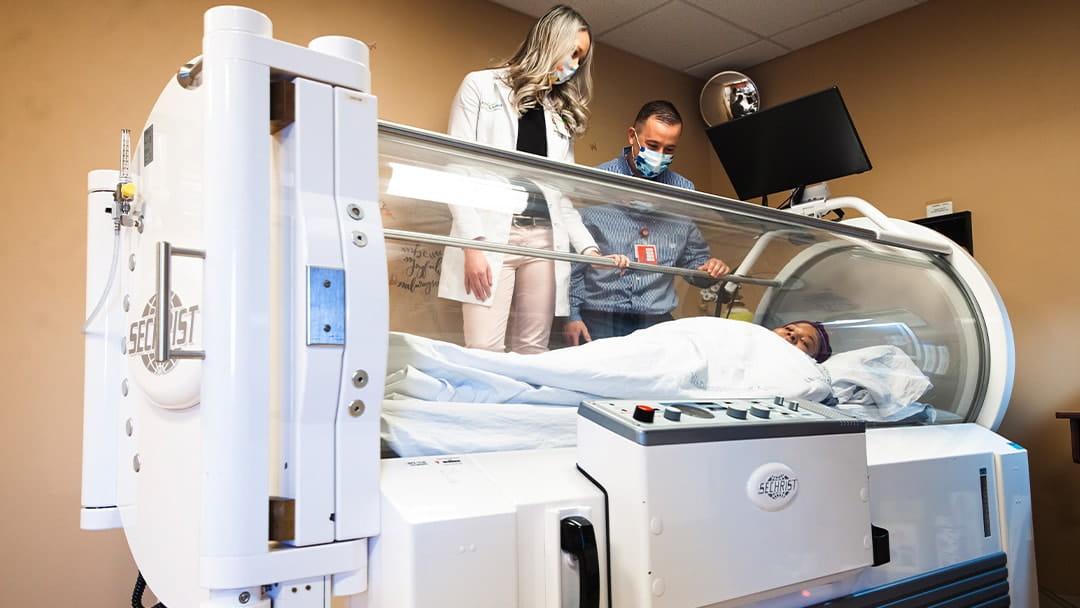Enhance Cerebral Blood Flow with HBOT
Hyperbaric oxygen therapy (HBOT) has been gaining traction as a holistic protocol for many different medical conditions. HBOT works to alleviate the symptoms associated with debilitating illnesses, improve overall health and fitness, and ultimately promote healing in the body.
The potential benefits of HBOT extend far beyond what we often think of when considering traditional therapies; this cutting-edge technology can help you live healthier lives well into old age. In this blog post, we’ll take a closer look at how Hyperbaric Oxygen Therapy (HBOT) can enhance cerebral blood flow and offer improved outcomes for those suffering from certain neurological disorders.
How does HBOT Increase Blood Flow?
Relieves any Obstruction
HBOT uses a combination of hyperbaric pressure, oxygen, and air to increase blood flow to the brain. By increasing atmospheric pressure around the body, this therapy helps reduce inflammation in the brain and promote healing. In addition to improving cerebral blood flow, HBOT is also used to boost immune system function, reduce swelling and speed up wound healing. Studies have revealed that this therapy can be beneficial for people with traumatic brain injury, stroke, and certain neurological disorders.
Dilates Blood Vessels:
The increase in oxygen helps dilate blood vessels, delivering more oxygen-rich blood throughout the body. This can help heal wounds, reduce inflammation, and improve overall tissue health. HBOT can also help treat conditions such as diabetes, stroke, autism, and cerebral palsy that are related to decreased oxygen levels in the body.
In addition to its therapeutic benefits, HBOT has been shown to improve cognitive function and concentration, boost immune system functioning, and reduce stress.
Effects of Improved Blood Flow on the Brain:
Cognitive Functions:
HBOT is particularly beneficial for improving cognitive functions, such as memory and concentration. HBOT works by exposing patients to increased atmospheric pressure in an enclosed chamber, delivering more oxygen-rich air into their bloodstreams. This helps to boost the oxygen levels in the brain, which can lead to improved cognitive function and mental clarity.
Studies have found that HBOT is particularly effective for those suffering from conditions such as stroke, dementia, autism, cerebral palsy, and ADD/ADHD. Additionally, HBOT has also been studied for its potential to help treat physical injuries and various illnesses, such as decompression sickness and radiation sickness.
With its ability to improve cognitive function and treat several medical conditions, HBOT is becoming increasingly popular among healthcare professionals. However, it should be noted that the effects of HBOT vary greatly from person to person and are not guaranteed.
Effects on TBI and other Brain Injuries
Hyperbaric oxygen therapy (HBOT) is a powerful tool for the protocol of traumatic brain injuries (TBI). It works by increasing the amount of oxygen available to the brain, which helps to accelerate healing and reduce symptoms. HBOT has been used successfully to treat a wide range of TBIs, from mild concussions to severe cases.
Studies have found that HBOT significantly improves outcomes for TBI patients, including improved memory and cognition, reduced symptoms of post-concussion syndrome, and improved quality of life. Furthermore, research has shown that HBOT can reduce the risk of long-term neurological damage associated with TBIs by helping to protect neurons from further injury due to lack of oxygen.
This makes it especially beneficial for patients who have experienced severe TBIs, as HBOT can reduce the risk of long-term disability or even death. HBOT is a safe and effective protocol for TBI, and it is highly recommended for those looking to recover from the effects of their injury.
It helps with Depression
Hyperbaric oxygen therapy (HBOT) is becoming increasingly recognized as an effective protocol for depression. Studies have shown that HBOT can not only help reduce symptoms of depression, but also increase the effectiveness of antidepressant medications in some cases. The therapy works by increasing the amount of oxygen available to the body, which helps boost neurotransmitter levels and increase brain activity. By providing the body with a larger amount of oxygen, HBOT helps to restore balance in areas of the brain that may be associated with depression.
HBOT can be used as a stand-alone protocol or in conjunction with other therapies. It is typically administered by placing patients in a pressurized chamber where they are exposed to enriched oxygen, allowing the body to absorb more of it than is possible with normal breathing. Depending on the severity of the depression and other factors, patients may need to undergo several sessions before they begin to see results.
It helps heal Parkinson’s disease
Hyperbaric oxygen therapy (HBOT) is an emerging protocol for people with Parkinson’s disease. It involves inhaling pure oxygen in a hyperbaric chamber or hbot chamber https://oxyhelp.com/hyperbaric-oxygen-chambers/ , which helps to deliver increased amounts of oxygen to the brain and body cells. This increased amount of oxygen helps promote the healing of damaged neurons and promotes better nerve cell function. Studies have shown that HBOT can reduce tremor intensity, improve mobility and cognition, and help to slow the progression of Parkinson’s symptoms.
In addition, HBOT may also help to improve the quality of life for people with Parkinson’s by helping them to feel more alert and energized. It is important to note that while HBOT is a promising protocol for Parkinson’s, it is not a cure and further research is needed to fully understand its potential benefits. However, it has shown promising results so far and may offer an effective way to help improve the lives of individuals with this chronic neurological disorder.
Is HBOT Safe for the Brain?
HBOT is considered generally safe for the brain. Studies suggest that HBOT may improve cognitive function in these patients. However, it is important to note that there can be certain side effects associated with HBOT. These include mild confusion, headaches, nausea, dizziness, and fatigue.
It is also possible for some people to experience seizures or worsening cognitive function in response to HBOT. Therefore it is important to discuss any potential risks with your doctor before starting protocol.
Additionally, the long-term use of HBOT has not been extensively studied and its safety profile in this setting is unknown.
Despite the many obvious health gains from this form of oxygen therapy, it provides an incredibly safe approach for increased blood flow to the brain making it an ideal way for people looking to improve their mental quotient without putting strain on their bodies.







